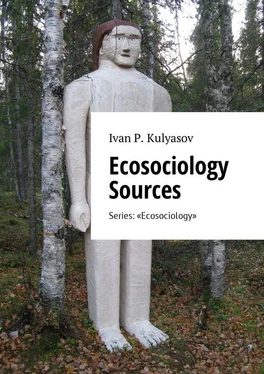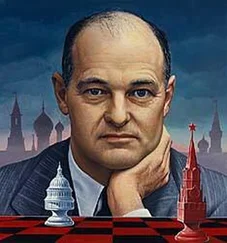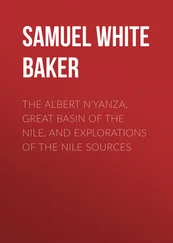I. Kulyasov - Ecosociology Sources. Series - «Ecosociology»
Здесь есть возможность читать онлайн «I. Kulyasov - Ecosociology Sources. Series - «Ecosociology»» — ознакомительный отрывок электронной книги совершенно бесплатно, а после прочтения отрывка купить полную версию. В некоторых случаях можно слушать аудио, скачать через торрент в формате fb2 и присутствует краткое содержание. ISBN: , Жанр: Прочая научная литература, на английском языке. Описание произведения, (предисловие) а так же отзывы посетителей доступны на портале библиотеки ЛибКат.
- Название:Ecosociology Sources. Series: «Ecosociology»
- Автор:
- Жанр:
- Год:неизвестен
- ISBN:9785449009913
- Рейтинг книги:5 / 5. Голосов: 1
-
Избранное:Добавить в избранное
- Отзывы:
-
Ваша оценка:
- 100
- 1
- 2
- 3
- 4
- 5
Ecosociology Sources. Series: «Ecosociology»: краткое содержание, описание и аннотация
Предлагаем к чтению аннотацию, описание, краткое содержание или предисловие (зависит от того, что написал сам автор книги «Ecosociology Sources. Series: «Ecosociology»»). Если вы не нашли необходимую информацию о книге — напишите в комментариях, мы постараемся отыскать её.
Ecosociology Sources. Series: «Ecosociology» — читать онлайн ознакомительный отрывок
Ниже представлен текст книги, разбитый по страницам. Система сохранения места последней прочитанной страницы, позволяет с удобством читать онлайн бесплатно книгу «Ecosociology Sources. Series: «Ecosociology»», без необходимости каждый раз заново искать на чём Вы остановились. Поставьте закладку, и сможете в любой момент перейти на страницу, на которой закончили чтение.
Интервал:
Закладка:
In Kovalevsky’s view, population growth is the main biosocial factor that directly impacts the economy as it results in economic change that brings about changes in politics, which, in turn, change social and private life. His theory of genetic (evolutionary) sociology describes and emphasizes the simultaneous interaction of individuals, groups and society in the natural physical environment and in the spiritual, cultural-historic and symbolic domains. He believed that prominent individuals had a mystical ability to control nature, resulting in recognition of power brokers by the general public. He examined and compared specific cases of historical development of nations and activities of social groups within these nations, trying to identify the reasons for the resulting social progress or for failure to achieve such progress 52 52 Kovalevsky M.M. Ethnography and sociology. Moscow. 1904.; Modern sociologists. Moscow. 1905.; Sociology. St. Petersburg. 1910. Vol. 1—2. (all in Russian)
. This method can be used in sociological analysis of ecological and anti-ecological practices, sustainable and non-sustainable economic development, ecological and anti-ecological polities, etc.
Believing that social change was now identified purely with psychological processes, De Roberti combined biology, sociology and psychology. He maintained that mental activity was manifested in the four basic methods of obtaining knowledge about oneself and the world, namely, science, philosophy, religion and arts, which determine practical activities, including productive ones. While admitting the importance of economic relations at a certain historical stage, he believed that psychological interaction played a key role.
Paying special attention to social progress and social evolution, interaction in small groups, and influence of social factors on the personality, he advocated the idea that all social interaction is a consequence of interactions between personalities, and therefore it is basically psychological. Hence, biology, or, more precisely, physiology and psychology are capable of explaining all social phenomena. At the same time, an individual’s activities are not dominated by biological characteristics. De Roberti’s biosocial theory emphasizes that human society has evolved from three forms of universal energy – non-organic, organic and supra-organic or psychic.
Paying special attention to social progress and social evolution, interaction in small groups, and influence of social factors on the personality, he advocated the idea that all social interaction is a consequence of interactions between personalities, and therefore it is basically psychological. Hence, biology, or, more precisely, physiology and psychology are capable of explaining all social phenomena. At the same time, an individual’s activities are not dominated by biological characteristics. De Roberti’s biosocial theory emphasizes that human society has evolved from three forms of universal energy – non-organic, organic and supra-organic or psychic 53 53 De Roberti E.V. Sociology. The main objective and its methodological features, place among the Sciences, the separation and the relationship with biology and psychology. St. Petersburg. 1880.; A new formulation of basic questions of sociology. Moscow. 1909.; Energy and sociology // Bulletin of Europe. St. Petersburg. 1910.; The concepts of mind and the laws of the universe. St. Petersburg. 1914. (all in Russian)
.
Kovalevsky and De Roberti became Russia’s first professional sociologists. They saw their task as providing insights on all theories, approaches and methods used in sociology. Lectures in sociology relied on factual material, supported by physiological and psychological data as well as by statistics, born as an exact science and dating back much earlier than the history of Russian sociology.
The first censuses of population and inventories of extracted natural resources started in Novgorod and Kiev in the 10 thcentury for the purposes of duty levying.
Ivan Kirillovich Kirillov (1689—1737) used the data from the 1710 census of peasant households and the first audit conducted in 1718, which provided the basis for his work “ The flourishing state of the Russian land… ", published in 1727. In 1734, he prepared the first statistical-economic survey in the form of a historical, ethnographic and economic atlas of Russia 54 54 Kirillov I.K. Flourishing condition of the all-Russian state… 1727.; Atlas of the Russian Empire. St. Petersburg. 1724—1731. (all in Russian)
.
In 1737, Vasily Nikitich Tatishchev (1686—1750) compiles the first questionnaire with guidelines for land surveyors, featuring questions in geography, geology, soil science, archeology, natural resource use, agriculture, industrial and backyard production, residential communities and residents, their culture and language. He dispatched the questionnaires himself and used the answers received in his work “ Introduction to the historical and geographical description of Russian Empire ” sending copies of the answers to the Russian Academy of Sciences.
In 1747, he wrote a scientific work on organization of census registration titled “ The reasoning for the audit of the polls… ", where he proposed to introduce a uniform census document, reduce census timeframes and improve qualifications of census takers 55 55 Tatishchev V.N. Introduction to the historical and geographical description of great Russian Empire. St. Petersburg. Part 1. 1950 (1744 manuscript).; The reasoning for the audit of the polls… St. Petersburg. Part 2. 1861 (1747 manuscript). (all in Russian)
.
In 1760, Mikhail Vasilyevich Lomonosov (1711—1765) presented his work “ Academic questionnaire ” containing 30 questions, some of which related to physical and economic geography and the rest – to culture, ways and methods of natural resource use. Unlike Tatishchev’s work, this questionnaire was dispatched to governors and regional academics by the government.
Academics then used the poll data for compiling a new “ Russian Atlas ” 56 56 L’Isle J.-N., Euler L., Von Winsheim C.N., Heinsius G., Miller F.I. Atlas of the Russian. Saint-Petersburg Academy of Sciences. 1745. (in Russian, Latin, German and French).
and Lomonosov – in his treatise “ On preservation and reproduction of the Russian people ”, where he suggested legislative and public measures aimed at increasing Russia’s population (increase in the birthrate, retention of those already born and measures to encourage foreigners to take Russian citizenship) 57 57 Lomonosov M.V. About preservation and reproduction of the Russian people. St. Petersburg. 1761. (in Russian)
.
In parallel with that, Feodor Ivanovich Miller (1705—1783) compiled “ Economic questions ”, another questionnaire that was similar to Lomonosov’s in its goals. It comprised 65 questions on the population structure, agriculture, industry and trade. This questionnaire was dispatched to governors, officials and major landowners. As a result, he wrote a number of works comprising historical, geographical and ethnographical materials 58 58 Miller F.I. A description of the Tomsk uyezd of the Tobolsk province in Siberia to its present position. St. Petersburg. 1734.; Description of the Siberian Kingdom and all occurred in it from beginning, and especially from its conquest by the Russian state at these times. St. Petersburg. 1750.; Description living in Kazan province pagan Nations, like the Cheremis, Chuvash and Votyaks. St. Petersburg. 1791.; Historical writings on the MaloRussian and the MaloRussians. Moscow. 1846.; History of Siberia. Moscow-Leningrad. 1939—1941. Vol. 1—2. 1999.; Moscow. 2000—2005. Vol. 1—3. (all in Russian)
.
Интервал:
Закладка:
Похожие книги на «Ecosociology Sources. Series: «Ecosociology»»
Представляем Вашему вниманию похожие книги на «Ecosociology Sources. Series: «Ecosociology»» списком для выбора. Мы отобрали схожую по названию и смыслу литературу в надежде предоставить читателям больше вариантов отыскать новые, интересные, ещё непрочитанные произведения.
Обсуждение, отзывы о книге «Ecosociology Sources. Series: «Ecosociology»» и просто собственные мнения читателей. Оставьте ваши комментарии, напишите, что Вы думаете о произведении, его смысле или главных героях. Укажите что конкретно понравилось, а что нет, и почему Вы так считаете.




![Джеймс Купер - Пионеры, или У истоков Саскуиханны [The Pioneers, or The sources of the Susquehannah]](/books/395797/dzhejms-kuper-pionery-ili-u-istokov-saskuihanny-t-thumb.webp)







